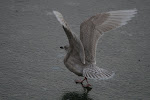Juvenile Marsh Warbler
2 Juvenile Marsh Warbler (left and right) and a juvenile Reed Warbler (middle) - note the yellow chins of the Marsh, the pink lower mandibles (rather than flesh) contrasting with the upper mandilble much more than on Reed, as well as the larger eyes.
Juvenile Marsh (left), Reed (right). Marsh is much more olive in colour and the tertials stand out much more as well as the stepping in the primaries appearing larger making the wings looks huge.
Juvenile Marsh Warbler - One of the first things to look for is the notch on the inner web of P9 as this falls well below the line of the tertials on a marsh and just under, equal or just over with Reed. The notch is also shorter (10mm on this bird with a wing of 70mm) than on Reed Warblers, so the longer wings cause the notch to fall much lower than on Reed.
The last Marsh Warbler of the day was a stunningly pale ginger bird that looked nothing like a Reed Warbler! Its fat pale bill, large eye and steep forehead gave it an almost Hippolais warbler feel!
CES ringing at Vallen this morning saw a large increase in juvenile warblers moving about with lots of Willow Warblers and Reed Warblers. The headline species for the day had to be Marsh Warbler, as we caught 7 throughout the session! It was great to see, at one point, 3 Marshies together with juvenile and 2CY Reed Warbler to see variation between the species and compare it to Reed.
The identification features had to be fully noted for the majority of birds, as only a couple of them really stood out as Marsh Warblers. These ID features were:
Wing Length - Marsh Warblers are longer winged than Reed Warbler so pretty much any Acro we get over 67/68, we check to make sure. Today's Marsh Warblers ranged from 67-71.
Notch on P9 - As stated above, the notch on P9 is one of the most sure fire ways of separating Marsh from Reed so this is used a lot as a quick check.
Feet - I think Marsh seem to climb more because they have longer toes than Reed with the outer toe being longer than the inner toe. I have also noticed that the claws on Marsh Warblers seem to be shorter, blunter and much a paler straw/yellow colour than on Reed. Whether this is a key feature, I don't know...
Bill - The bill is generally shorter on a Marsh and wider at the base, as well as the lower mandible being all over pale and pink, which doesn't seem common in Reed as their colour is more flesh colour with a darker smudge towards the tip.
Jizz of the bird - in the hand, they appear more like a Hippolais warbler with a big eye and bill, and they seem to be all over green tinged which is really obvious on some birds, but less on others. Juveniles seem to have more of a hint of yellow throughout the plumage which can make it look very warm like a Reed. The Forehead is steeper on a Marsh too, which again changes the look of the bird.
Other highlights for the day out the 126 birds (inc. 18 recap) caught were 3 Great Reed Warblers, another juvenile Red-backed Shirke, Icterine Warbler and several Thrush Nightingale.
Totals for the day: (retraps in brackets)
Marsh Warbler - 7
Reed Warbler - 36 (5)
Sedge Warbler - 12 (2)
Willow Warbler - 27 (3)
Great Reed Warbler - 1 (2)
Icterine Warbler -1
Garden Warbler - 4
Whitethroat - 1 (1)
Lesser Whitethroat - 2
Blue Tit - 4 (1)
Great Tit - 3
Thrush Nightingale - 1 (2)
Blackbird - 2 (1)
Red-backed Shirke - 1
Great-spotted Woodpecker - 1
Greenfinch - 3
Reed Bunting - 1
Pied Flycatcher - 1
Note: Just a side note from the ringing day was a 3rd calender year+ Reed Warbler we caught aged by the colour of it's eye, the paleness of it's legs and the complete lack on tongue spots. I am amazed that they aren't aged the same way in England, as the eye alone surely makes birds stand out like a sore thumb! It was honestly the same colour as a Great-spotted Woodpecker's eye (maybe not THAT red, but it made the bird look evil!). It's the first 3CY+ I've seen since my first couple of days here and it may as well have been wearing a sign. Interesting bird nonetheless.






2 comments:
Some 3+cy Reed Warblers are aged as such in England, you just have to go ringing with the right people ;)
It's all good and well that birds are aged as such (as I'm sure you were taught this at Falsterbo, if not beforehand), but as far as I'm aware, the BTO reject the age and put them as 4's? Am I wrong?
Post a Comment